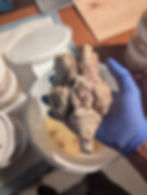

THE EVOLVING BRAIN LABORATORY
Our mission is to embrace the diversity of mammalian brain architecture at all levels of analysis and to use knowledge garnered from this to help us understand the emergence of the human brain and ariation in brain function and disease liability.
MORPHOLOGY.BEHAVIOR.EVOLUTION




The Evolving Brain Laboratory (EBL) is an educational and research initiative dedicated to the study of comparative neuroanatomy and the evolutionary origins of the human brain.
Our Work: We use a histological framework in conjunction with phylogenetically informed procedures to investigate the neuroanatomical features underlying the behavioral repertoire of mammalian species.
Our Focus: To date our work has primarily centred around the study of brain asymmetry, exploring scaling relationships at different levels of organization and characterizing the phenotypic changes that accompanied the evolution of large brains.
NEWS
Gray matter volume and asymmetry in Broca’s and Wernicke’s area homolog in chimpanzees. Read our recently published manuscript on asymmetry in the chimpanzee neocortex!
Listen to the full Deep Dive podcast - link
Neuropil and Chill - What your cats brain is really doing at 3am. Read a snippet from the Neurothreads blog on our comparative neuropil work in Big Cat species
Dolphins have small hippocampi that lack adult neurogenesis
Predicting subcortical brain anatomy in fossil Carnivoral! Read our recently published manuscript in JCN and a snippet from the neurothreads blog - Breathing life into fossil endocasts.
A brief Nature commentary by Dr. Spocter on the canine facial expression - Puppy Dog eyes in wild canines sparks rethink on dog evolution
Learn more about some of our ongoing work on domestication in the Canid and Artiodactyl brain.
Neuro-SMART high school students present their research at the DMU Research Symposium.
Our Commitment to the region has also seen us gear some of our work towards the study of indigenous and domestic animals that play a pivotal role in the livelihood of the local community.
We are located within the Anatomy Department at Des Moines University upon the backdrop of the beautiful and friendly City of West Des Moines, Iowa. PI- Muhammad Spocter
Are you Interested in obtaining a Masters or PhD degree in comparative neuroanatomy? - Check out Des Moines Universities MSA Masters in Anatomy Thesis and PhD in Biomedical Sciences programs.
Central Campus and EBL awarded a Verizon Foundation Innovative Learning Grant to expand their high school brain research module!
WELCOME




UPCOMING EVENTS
CONTACT US
13 NOV
The 37th Karger Workshop in Evolutionary Neuroscience
8025 Grand Avenue
Department of Anatomy
Des Moines University
West Des Moines, IA 50266
Tel: 515-271-7485
14 NOV
44th Annual Meeting of the J.B. Johnston Club for Evolutionary Neuroscience ABOUT
25, 26 JULY
Past events
Neuroanatomy in an Afternoon- Teachers Workshop- Free!
Target Audience: High School & Community College science educators - REGISTRATION
12 May
The JBJC Spring Virtual Symposium - REGISTRATION
16 JAN
First day of class for the Spring semester of the high school comparative neuroanatomy STEM Class (Neuro-SMART)

FOLLOW US
LAB ANNOUCEMENTS
The EBL wishes to welcome
MSA student - Marlee Wall
to the graduate program
here at DMU! Marlee joins us
from Purdue University with
a background in cognitive neuroscience and anthropology. Marlee will be working on the comparative anatomy of the limbic system in chimpanzees.
The Neuro-SMART program
awarded a STEM BEST® award
from the Iowa Governor's STEM Advisory Council. This program is now recognized as one of 50 innovative models in Iowa working to unite the workplace with the classroom.

We completed our preliminary description of the major sensory cortical areas of the African Wild Dog (Lycaon pictus). This work was the result of a Carnegie-Wits Alumni fellowship funding collaborative links between Des Moines University and the University of Witwatersrand (South Africa).




